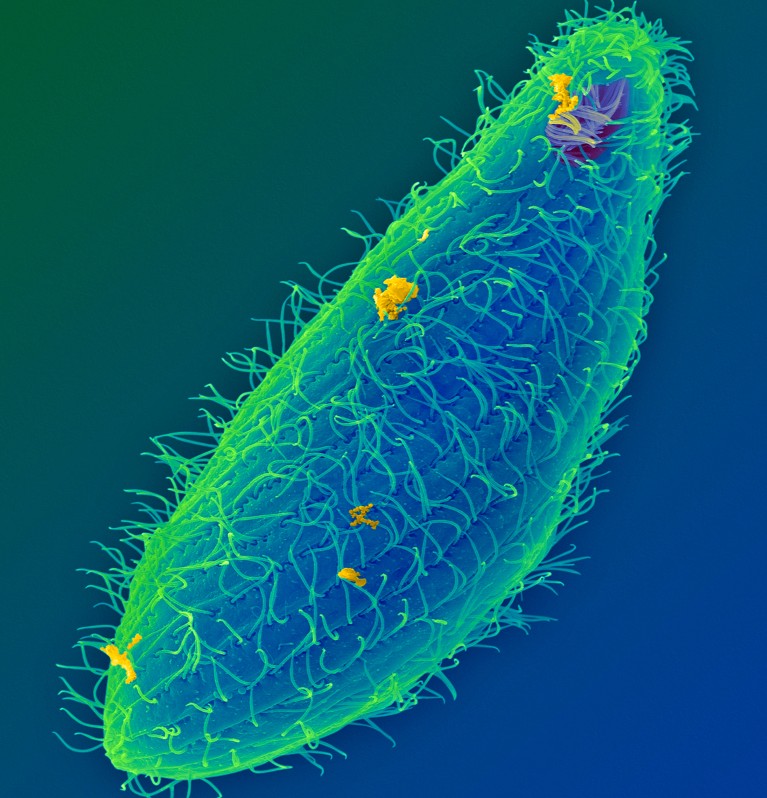
mRNA technology was the foundation of one vaccine that helped to quell the COVID-19 pandemic.Credit: Davide Pischettola/NurPhoto/Getty
The Catalyst: RNA and the Quest to Unlock Life’s Deepest Secrets Thomas R. Cech W. W. Norton (2024)
In the past decade, RNA has risen from obscurity to the cutting edge of biotechnology. It has become clear that the molecule is a multifaceted player in evolution and cell biology, with a panoply of functions. In The Catalyst, Nobel-prizewinning chemist Thomas Cech tells the story of the discoveries that propelled RNA to the heart of modern laboratory techniques, gene-editing approaches and therapeutics.
“Folding into origami-like shapes, it can pull off wild stunts that make its genetic parent, DNA, look like a one-trick pony,” Cech notes. Having spent most of his career studying RNA, the author has rare insights into the cast of characters and the serendipitous events that led to this understanding. His lucid, engaging and clear account will appeal to general readers and specialists alike.
The vaccine shots that rang around the world
The first half of The Catalyst recounts how, in the mid-twentieth century, growing knowledge of the genetic code led to the discovery of messenger RNA — the intermediary molecule transcribed from DNA that is used as a template to produce proteins. Sixteen years later, researchers made the startling realization that genes in plants, fungi and animals are fragmented, often containing seemingly nonsensical internal sequences, called introns, that are cut out of transcripts before mRNA is translated into protein. This discovery was perhaps the biggest surprise in the history of molecular biology — no one had predicted that gene sequence would not correspond precisely to protein sequence.
Cech, now at the University of Colorado Boulder, tells the fascinating inside story of his own work, which in 1989 earned him a Nobel prize, shared with the late molecular biologist Sidney Altman, for the discovery that RNA could have catalytic properties. In the late 1970s, as a new principal investigator, Cech began to study gene transcription in the tiny aquatic organism Tetrahymena thermophila, focusing on a simple gene that contained one intron. At the time, it was commonly accepted that all enzymes — which catalyse chemical reactions — were proteins. But he unexpectedly found one that wasn’t. The enzyme in Tetrahymena that chopped out introns was made of RNA.
The author spent a year fastidiously verifying his result with collaborator Art Zaug, an RNA scientist at the University of Colorado Boulder, excluding alternative explanations one by one in a process that Cech calls “plucking the daisy petals”. His candid description of their detailed sleuthing is a testament to how careful experimentation and open minds can overcome the dead weight of dogma.

Tetrahymena thermophila, the aquatic organism in which the ribozyme was discovered.Credit: Dennis Kunkel Microscopy/SPL
By showing that RNA could have catalytic activity, Cech’s discovery added credence to the idea that RNA pre-dated proteins in the origin of life. There are two key requirements for life: a molecule must be able to store genetic information and to replicate itself, which necessitates catalytic reactions. It was already clear that RNA fulfilled the first requirement; Cech’s discovery hinted that it might fulfil the second. Jennifer Doudna, currently a biochemist at the University of California, Berkeley, who worked as a postdoc in Cech’s lab, and Jack Szostak, now a chemist at the University of Chicago in Illinois — both of whom would later win their own Nobel prizes for other discoveries — set to work to show that Cech’s RNA enzyme, which was named the ribozyme, could not only cut RNA, but also be coaxed to replicate it. The field is still debating whether life might have started with RNA, but the molecule is now widely accepted as a key player.
Therapeutic opportunities
The second half of the book discusses how RNA can regulate the activity of genes and outlines how gene-editing tools and therapeutics have been developed, thanks to basic research into RNA’s myriad functions.
Cech describes how ‘microRNAs’ and ‘small interfering’ RNAs guide protein enzymes called Argonautes to cut — and thus inactivate — specific mRNA sequences to control their expression. These RNAs are being adapted to treat neurological disorders, and a similar approach is being explored to inactivate the toxic mRNAs that accumulate in the brain in debilitating neurodegenerative diseases, such as amyotrophic lateral sclerosis.
The mRNA vaccines that beat back COVID-19 were developed in less than a year. But they were built on the back of decades of work on ways to modify RNAs to deliver them into cells. Similar vaccines are now being developed to combat the deadly respiratory syncytial virus, the common cold and even cancer.
The research aiming to keep people healthier for longer
One of the most-used applications of RNA is in the CRISPR–Cas gene-editing system, pioneered in 2012 by Doudna and others. In bacteria, a CRISPR RNA acts as a guide that leads an enzyme — Cas — to cut and destroy the DNA of invading viruses. Gene-editing technologies co-opt this defence mechanism to make targeted edits to DNA in any cell in any species. In a little more than ten years, the use of CRISPR for gene editing has become so ubiquitous that, Cech notes, “it’s become a verb, like ‘google’”. Today, modified CRISPR systems are being used in diverse applications from agriculture to synthetic biology, and have been approved to treat some genetic disorders, including sickle-cell anaemia.
Cech concludes by extolling the importance of curiosity-driven research, so beautifully exemplified in The Catalyst. He flags the mystery of ‘long noncoding’ RNAs — hundreds of thousands of which are produced at low levels in human cells and tissues, with fewer produced in simpler species. Some scientists have been inclined to dismiss these RNAs as meaningless accidents of transcription. But, as the author points out, catalytic and microRNAs might easily have been dismissed as junk not so long ago. Indeed, Cech asks, might these enigmatic RNAs hold the key to understanding what makes us human? Finding the answer, he predicts, will probably fill “future chapters in the book of RNA”.
The Catalyst does a magnificent job of explaining complex concepts and experimental techniques. I’ve worked in this field for 30 years, and still enjoyed learning the stories behind the discoveries that have shaped RNA biology and biotechnology. Cech asks readers to look beyond the textbooks, to future discoveries. As his compelling book emphasizes, we should “never underestimate RNA”.
Competing Interests
The author declares no competing interests.




